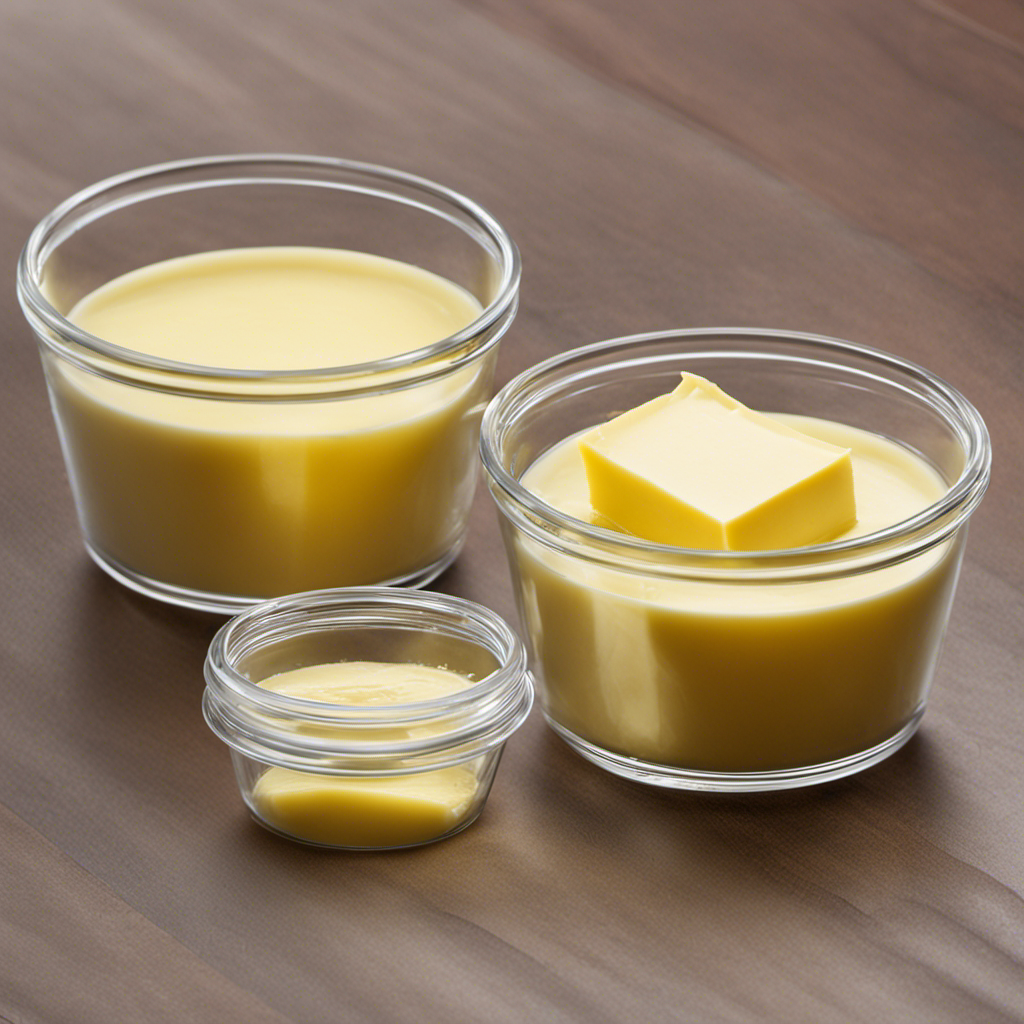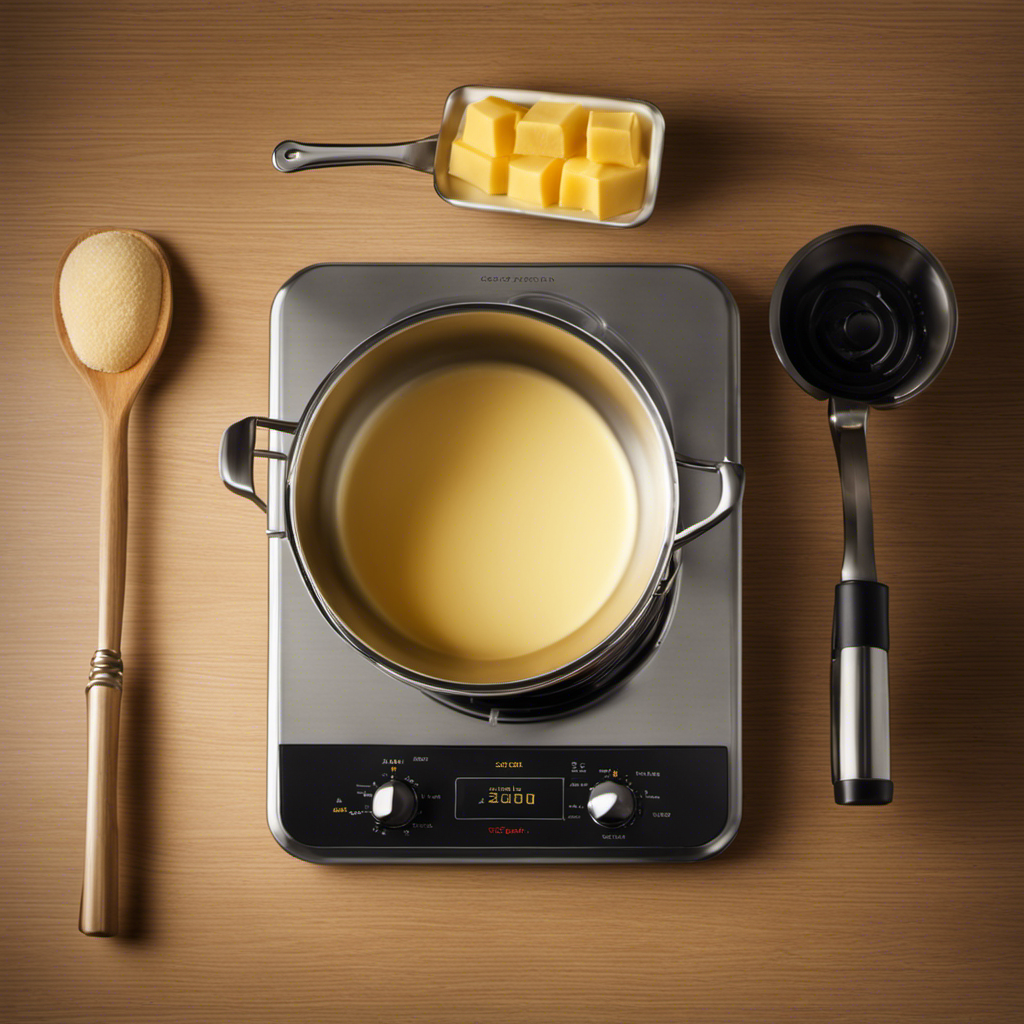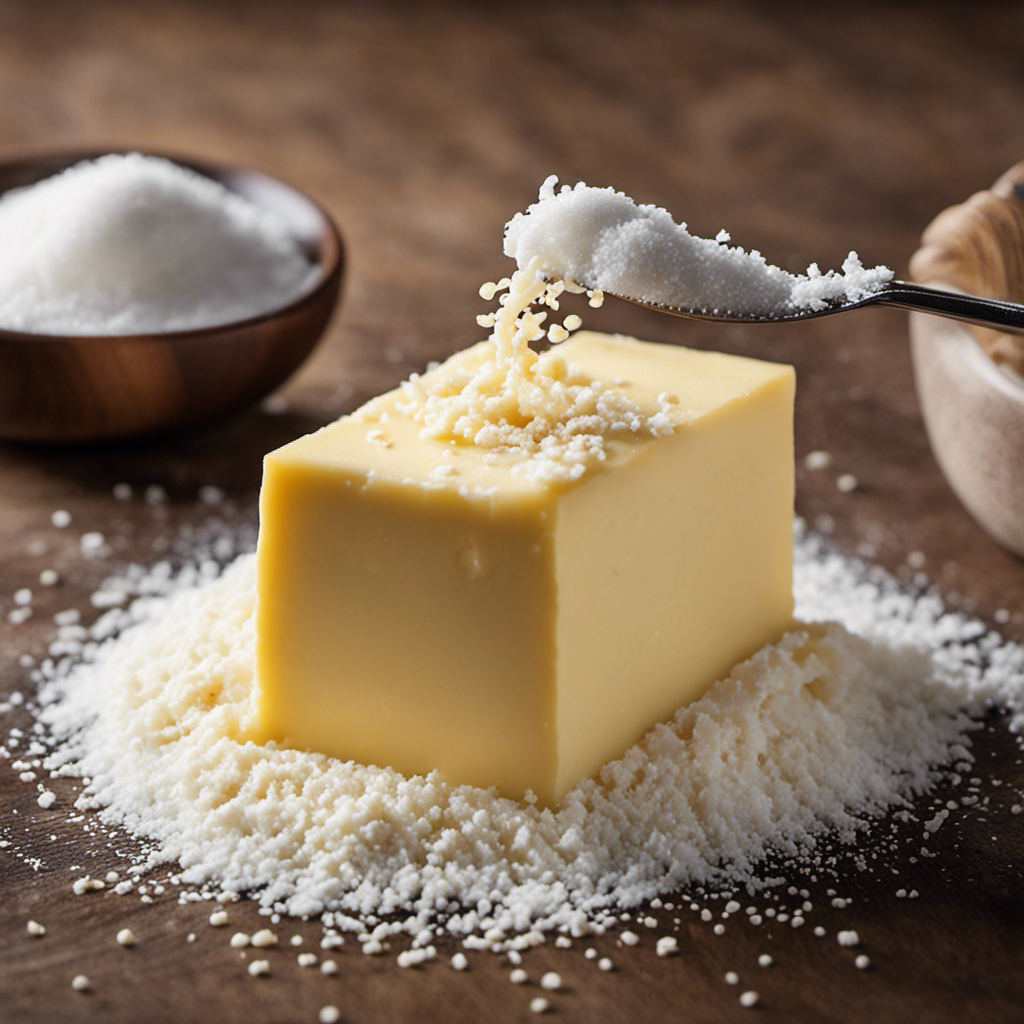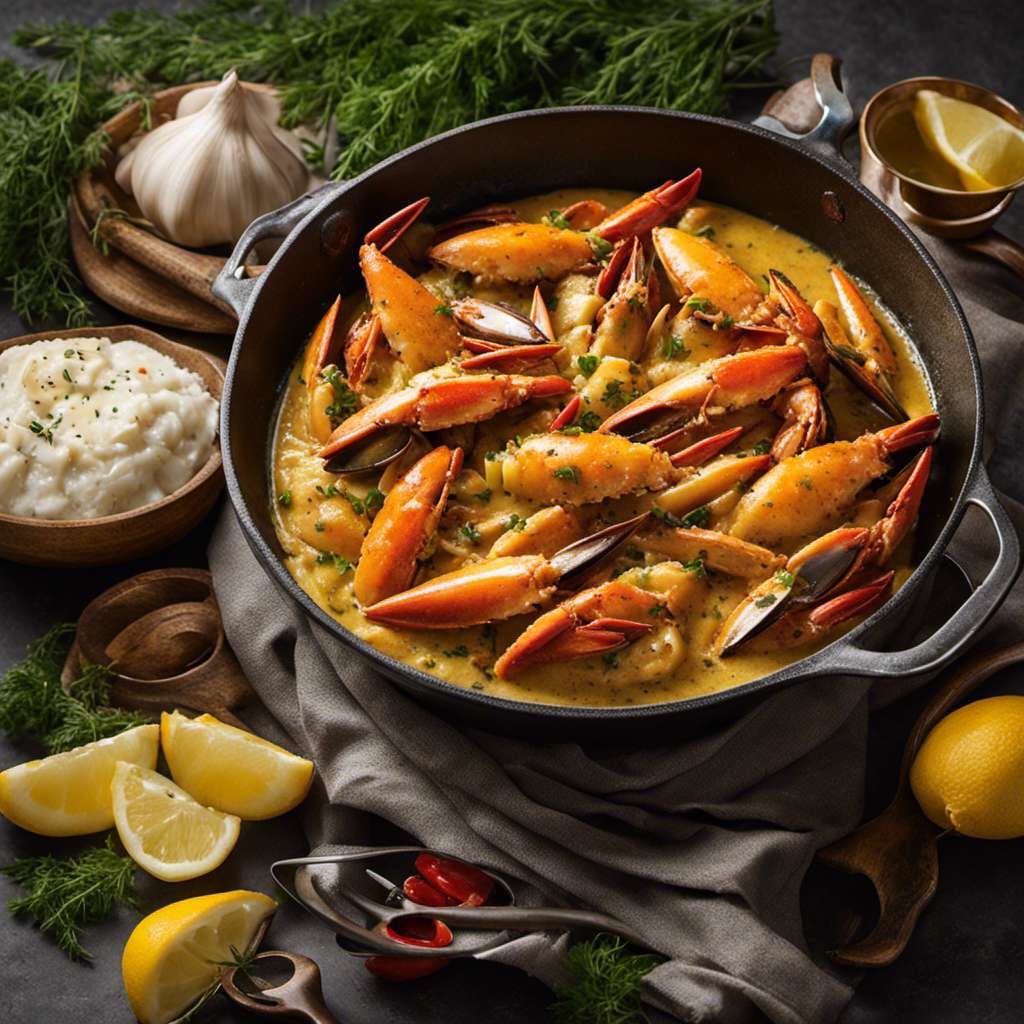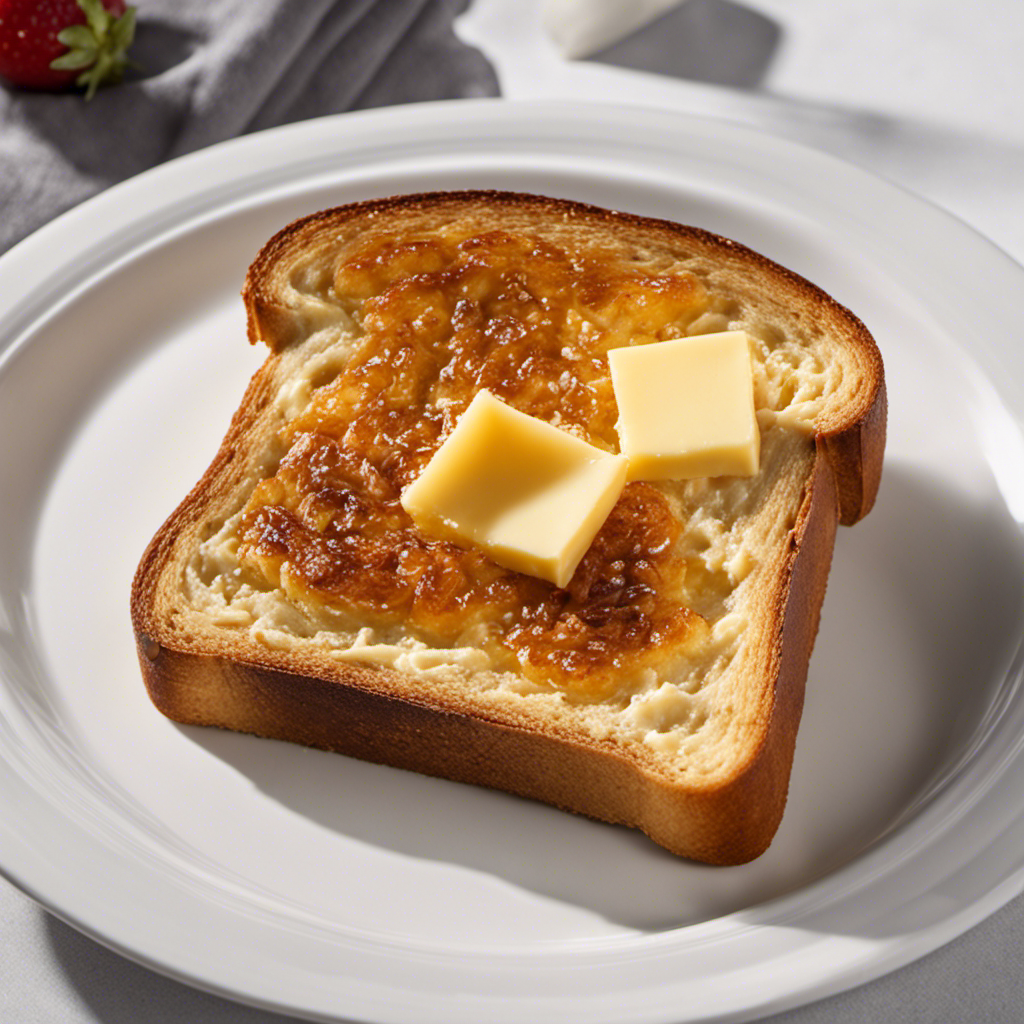Alright, everyone, let’s address the pressing question of the day: what exactly is half of 3/4 cup of butter? Don’t worry, because I have the answers you need.
In this article, I’ll break down the measurement, show you how to convert it to tablespoons, and even guide you through the process of measuring that elusive half.
Stick around for some alternative methods and handy tips to make your butter-baking adventures a breeze.
Let’s dive in and demystify the mathematics of butter, shall we?
Key Takeaways
- 3/4 cup of butter can be simplified to 1/2 cup plus 1/4 cup.
- Half of 3/4 cup of butter is equal to 3/8 cup.
- Converting cups to tablespoons, 3/4 cup of butter is equivalent to 12 tablespoons.
- When adjusting recipes, it is important to understand butter measurement equivalents and adjust accordingly.
Understanding the Measurement
Understanding the measurement can be tricky when you’re trying to figure out what is half of 3/4 cup of butter. Measuring equivalents and fractional measurements play a crucial role in achieving accurate results in the kitchen.
When it comes to fractions, it’s important to break them down to their simplest form. In this case, 3/4 cup can be simplified to 1/2 cup plus 1/4 cup.
To find half of 3/4 cup, you would divide 1/2 cup by 2, resulting in 1/4 cup. Therefore, half of 3/4 cup of butter is 1/4 cup.
It’s essential to understand these measurements to ensure the right proportions in recipes and achieve the desired outcome.
Converting 3/4 Cup to Tablespoons
Converting 3/4 cup to tablespoons can be done easily. To convert from cups to tablespoons, you simply need to multiply the cup measurement by 16. So, for 3/4 cup, the conversion would be:
| Cups | Tablespoons |
|---|---|
| 3/4 | 12 |
This means that 3/4 cup is equivalent to 12 tablespoons.
Now, if you want to convert the measurement to grams or ounces, you can use the following conversions:
- 1 tablespoon is approximately 14.79 grams or 0.52 ounces.
- 3/4 cup, which is equal to 12 tablespoons, would be approximately 177.44 grams or 6.15 ounces.
By using these conversions, you can easily determine the equivalent measurements in grams or ounces for 3/4 cup of any ingredient.
Moving on to the next section, let’s find out what is half of 3/4 cup.
Finding Half of 3/4 Cup
To find half of 3/4 cup, you can simply divide it by 2.
Converting fractions to find a specific portion of a measurement is a common task in cooking and baking. In this case, we are looking to find half of 3/4 cup.
To do this, we divide 3/4 by 2. When we divide 3/4 by 2, we get 3/8. So, half of 3/4 cup is equal to 3/8 cup.
It’s important to note that this is an exact measurement and is not an estimation. If you prefer to convert this to tablespoons, you can use a conversion chart or calculator. However, it’s always a good idea to have a visual estimation of the measurement as well to ensure accuracy in your cooking and baking.
Measuring Half of 3/4 Cup
When measuring, it’s important to divide 3/4 cup in half in order to accurately follow a recipe. To do this, you can use a few different methods to ensure measuring accuracy.
-
Method 1: Use a measuring cup with clear markings to measure 3/4 cup of butter. Then, using a knife or a spatula, divide the measured amount in half, making sure to remove excess butter if needed.
-
Method 2: If you have a kitchen scale, you can weigh 3/4 cup of butter and then divide the weight in half. This method provides precise measurements.
When it comes to butter substitutes, it’s important to note that different substitutes may have different densities and moisture content. This can affect the accuracy when measuring and halving the amount. It’s always a good idea to check the manufacturer’s instructions for the specific butter substitute you are using to ensure accurate measurements.
Alternative Ways to Measure Half of 3/4 Cup
When it comes to measuring ingredients, there are various methods you can use to ensure accuracy.
Different measuring utensils, such as cups and spoons, provide precise measurements for liquids and dry ingredients.
However, if you don’t have these utensils on hand, you can also rely on eyeballing the measurement or using a digital scale for more precision.
Different Measuring Utensils
Using different measuring utensils can help accurately measure ingredients for a recipe. When it comes to measuring accuracy, it’s important to have alternative units to ensure precision. Here are two sub-lists that provide a visual representation of ideas:
-
Measuring Cups:
-
Standard measuring cups are commonly used for dry ingredients.
-
Liquid measuring cups are designed to accurately measure liquids.
-
Measuring Spoons:
-
Measuring spoons are used for small quantities of ingredients.
-
They come in different sizes, such as 1/4 teaspoon, 1/2 teaspoon, 1 teaspoon, and 1 tablespoon.
By using these different measuring utensils, you can ensure that you’re measuring ingredients accurately and precisely, which is crucial for a successful recipe.
Now let’s explore another method of measuring called ‘eyeballing the measurement’, which can be handy in certain situations.
Eyeballing the Measurement
To accurately estimate measurements, you can try eyeballing the amount of ingredients. Eyeballing is a method of visual estimation that relies on your ability to judge quantities with your eyes. While it may not provide the same level of accuracy as using measuring utensils, it can be a useful technique in certain situations.
When eyeballing measurements, it’s important to consider factors such as the size of the container, the density of the ingredient, and your own experience and judgment. Keep in mind that eyeballing may not be suitable for all recipes, especially those that require precise measurements for optimal results.
However, with practice and a keen eye, you can improve your eyeballing accuracy and confidently estimate ingredient amounts in your cooking and baking endeavors.
Using a Digital Scale
A digital scale is a helpful tool that can provide precise measurements for your recipes. It offers numerous benefits and ensures accurate measurements, making it an essential tool for any home cook or baker.
Benefits of using a digital scale:
- Precision: Digital scales provide accurate measurements in grams or ounces, allowing for precise ingredient ratios.
- Easy to use: These scales are user-friendly and often come with features like tare function, which allows you to weigh ingredients in a container without including the weight of the container itself.
Measuring accuracy:
- A digital scale eliminates the guesswork involved in measuring ingredients by volume, ensuring consistency in your recipes.
- It allows you to easily convert measurements from one unit to another, making it convenient when following recipes from different sources.
Overall, using a digital scale greatly improves the accuracy and precision of your measurements, resulting in better and more consistent cooking and baking outcomes.
Tips for Using Half of 3/4 Cup of Butter
In this discussion, I’ll be addressing the topic of butter measurement conversion and providing suggestions for adjusting recipes accordingly.
When it comes to converting measurements for butter, it’s important to have accurate conversions in order to achieve desired results. Understanding how to adjust recipes when using different amounts of butter can help ensure the desired taste and texture of the final dish.
Butter Measurement Conversion
You can easily convert the measurement of 3/4 cup of butter into half. To do this, you need to know the butter measurement equivalents. Here are some butter measurement tips to help you:
- Convert 3/4 cup of butter into half:
- Step 1: Divide the numerator (3) by 2 to get 1.5.
- Step 2: Keep the denominator (4) the same.
- Step 3: Combine the new numerator (1.5) with the original denominator (4) to get 1.5/4 cup of butter.
Other common butter measurement equivalents:
- 1 stick of butter = 1/2 cup = 8 tablespoons = 4 ounces
- 1 pound of butter = 4 sticks = 2 cups = 32 tablespoons
Remember to adjust your recipe accordingly when using different measurements of butter. By understanding butter measurement conversions, you can confidently modify recipes to suit your needs.
Recipe Adjustment Suggestions
To modify your recipe, consider adjusting the amount of butter used based on the measurement equivalents provided. One way to modify a recipe is to substitute butter with a healthier alternative, such as olive oil or coconut oil. By making this substitution, you can reduce the saturated fat content in your recipe while still maintaining flavor and texture. Additionally, you can adjust the amount of butter used by referring to the table below, which provides measurement equivalents for different quantities of butter.
| Butter Quantity | Equivalent Measurement |
|---|---|
| 1/4 cup | 4 tablespoons |
| 1/2 cup | 8 tablespoons |
| 3/4 cup | 12 tablespoons |
| 1 cup | 16 tablespoons |
Frequently Asked Questions
Can I Use Margarine Instead of Butter When Measuring Half of 3/4 Cup?
Yes, you can use margarine instead of butter when measuring half of 3/4 cup. Margarine is a suitable substitute for butter in most recipes and can be measured in the same way.
How Do I Measure Half of 3/4 Cup if I Don’t Have a Measuring Cup?
I measure half of 3/4 cup without a measuring cup by using alternative methods. Estimating measurements accurately is important when cooking without precise tools. Here are some tips for doing so.
What Is the Weight Equivalent of Half of 3/4 Cup of Butter?
To find the weight equivalent of half of 3/4 cup of butter, you can use a conversion factor. Without the context of "What Is Half of 3/4 Cup of Butter," I would explain how to calculate it.
Can I Use a Scale to Measure Half of 3/4 Cup of Butter?
Yes, a scale can be used to measure half of 3/4 cup of butter. It’s a precise and accurate method. If you don’t have a scale, using margarine as an alternative is also possible.
Are There Any Substitutes for Butter When Measuring Half of 3/4 Cup?
When measuring butter without a measuring cup, substitute options for butter include margarine, shortening, or oil. These alternatives can be used in the same quantity as half of 3/4 cup of butter.
Conclusion
In conclusion, finding half of 3/4 cup of butter is a process that requires precision and careful measurement. By converting 3/4 cup to tablespoons and then dividing by 2, we can determine the exact amount needed.
Measuring half of 3/4 cup can be done using a knife or a kitchen scale for accuracy. However, alternative methods such as eyeballing or using a butter cutter may also be used.
Remember to follow these tips to ensure the perfect measurement of half of 3/4 cup of butter.
